Thomas James Richards, Diaries, Transcript Vol. 4, 9 November 1916 - 31 May 1918 - Part 28
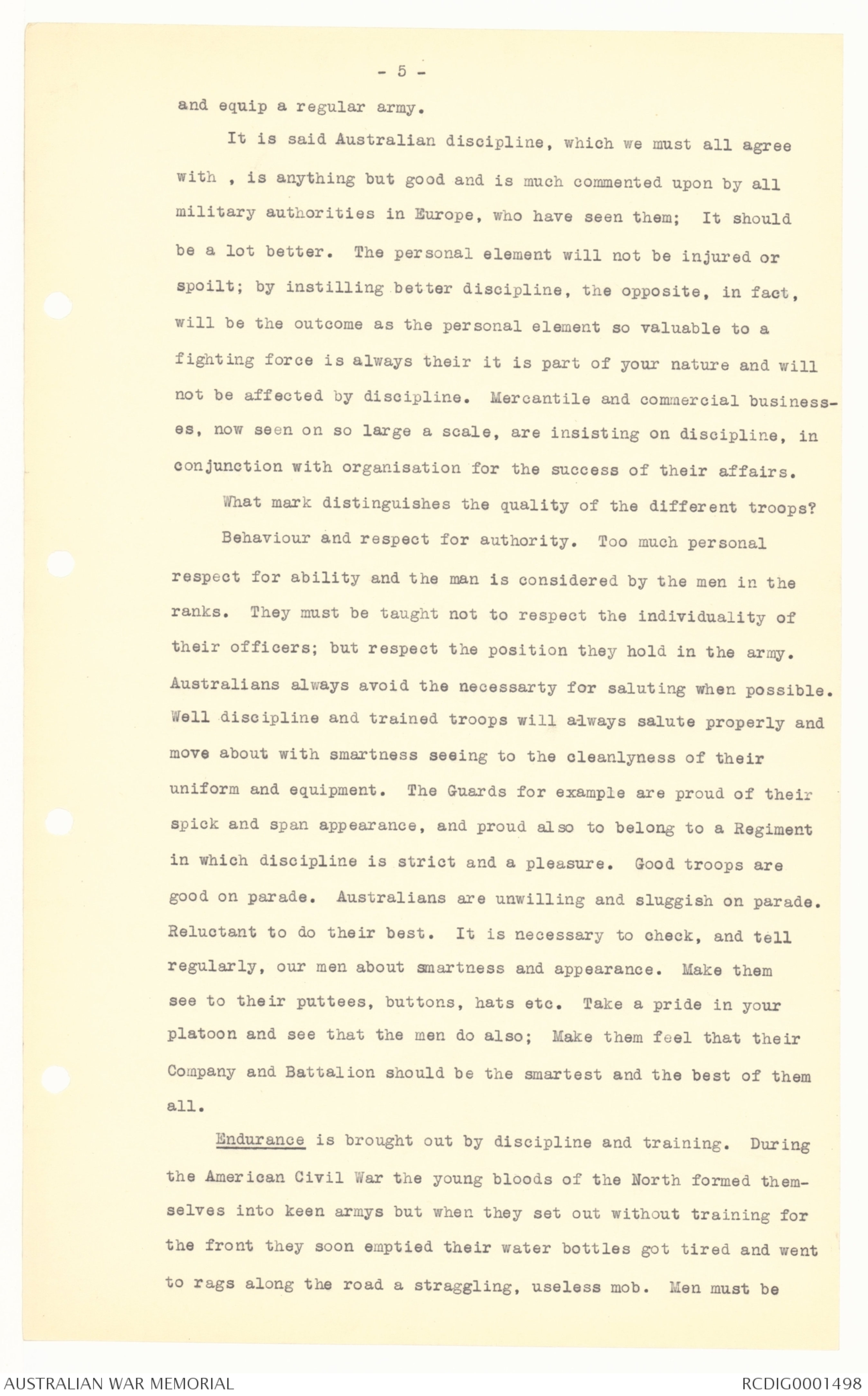
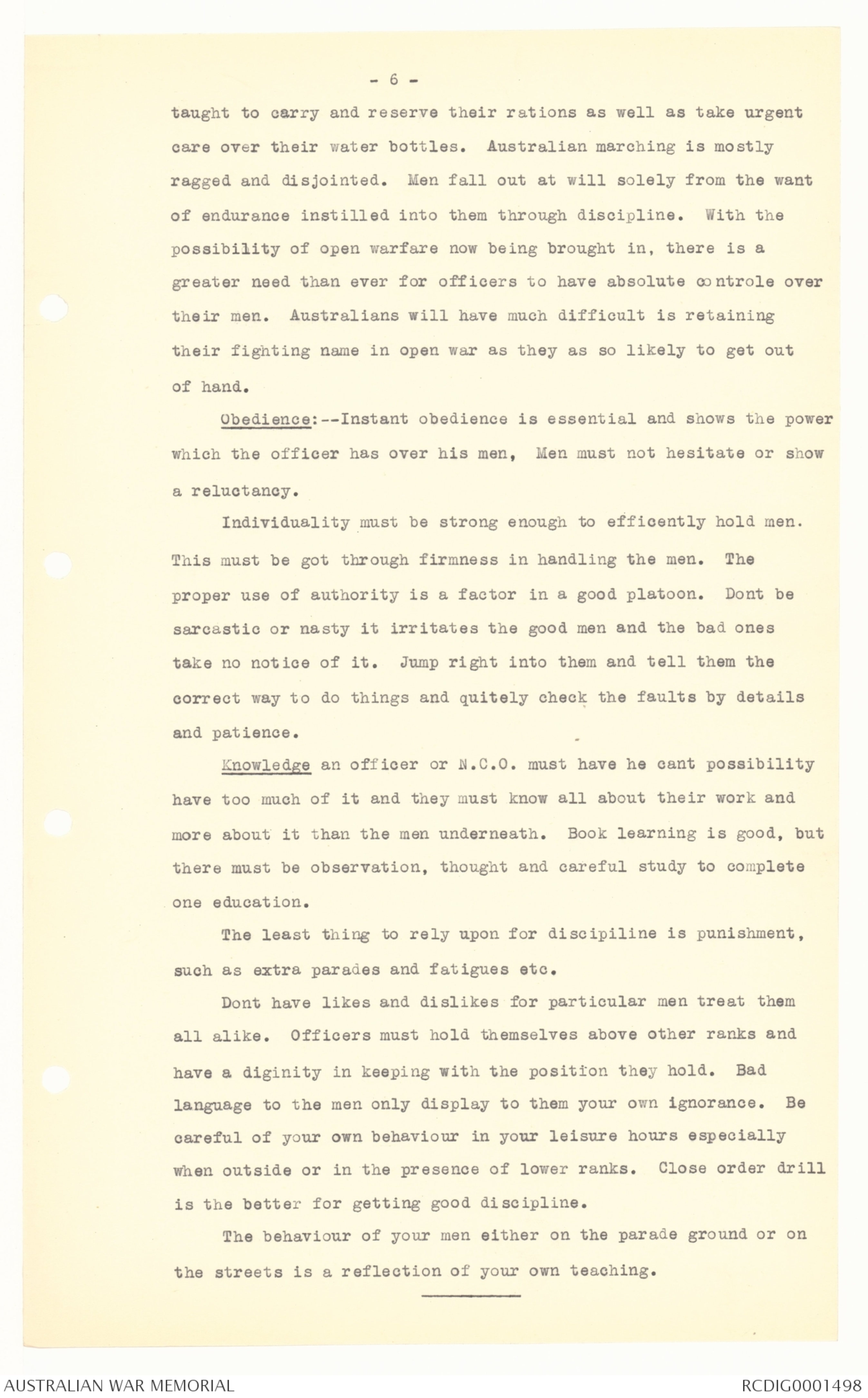
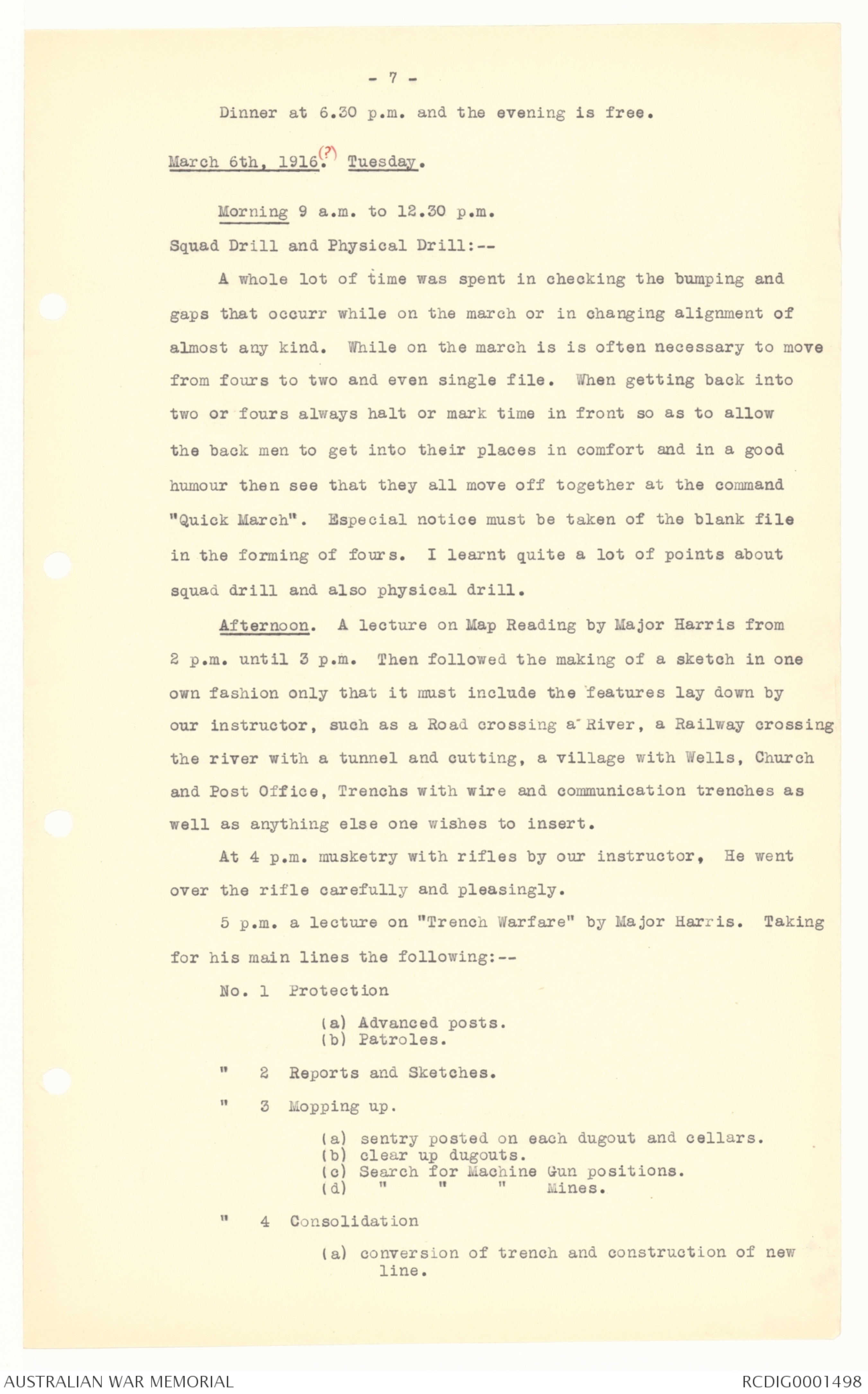
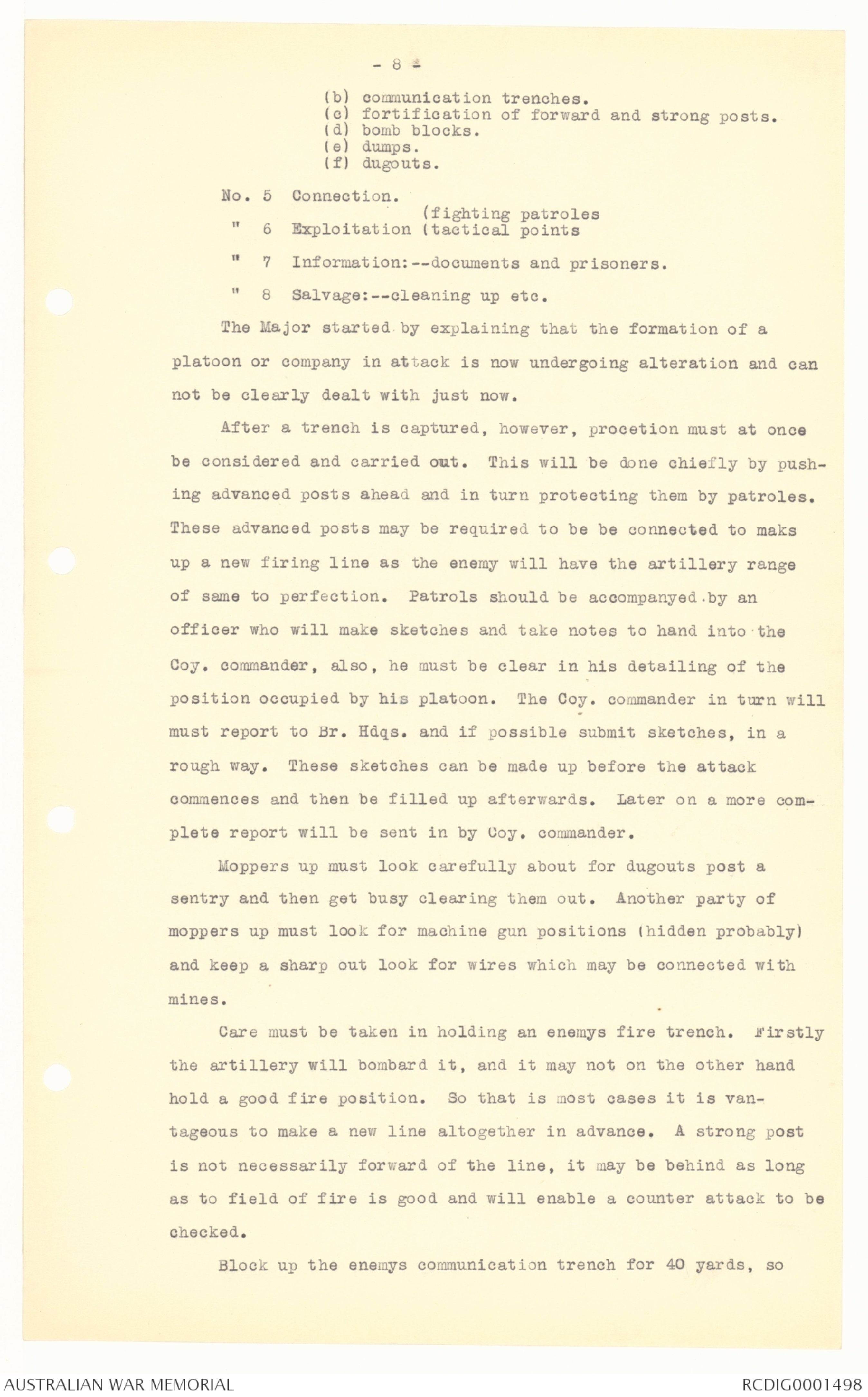
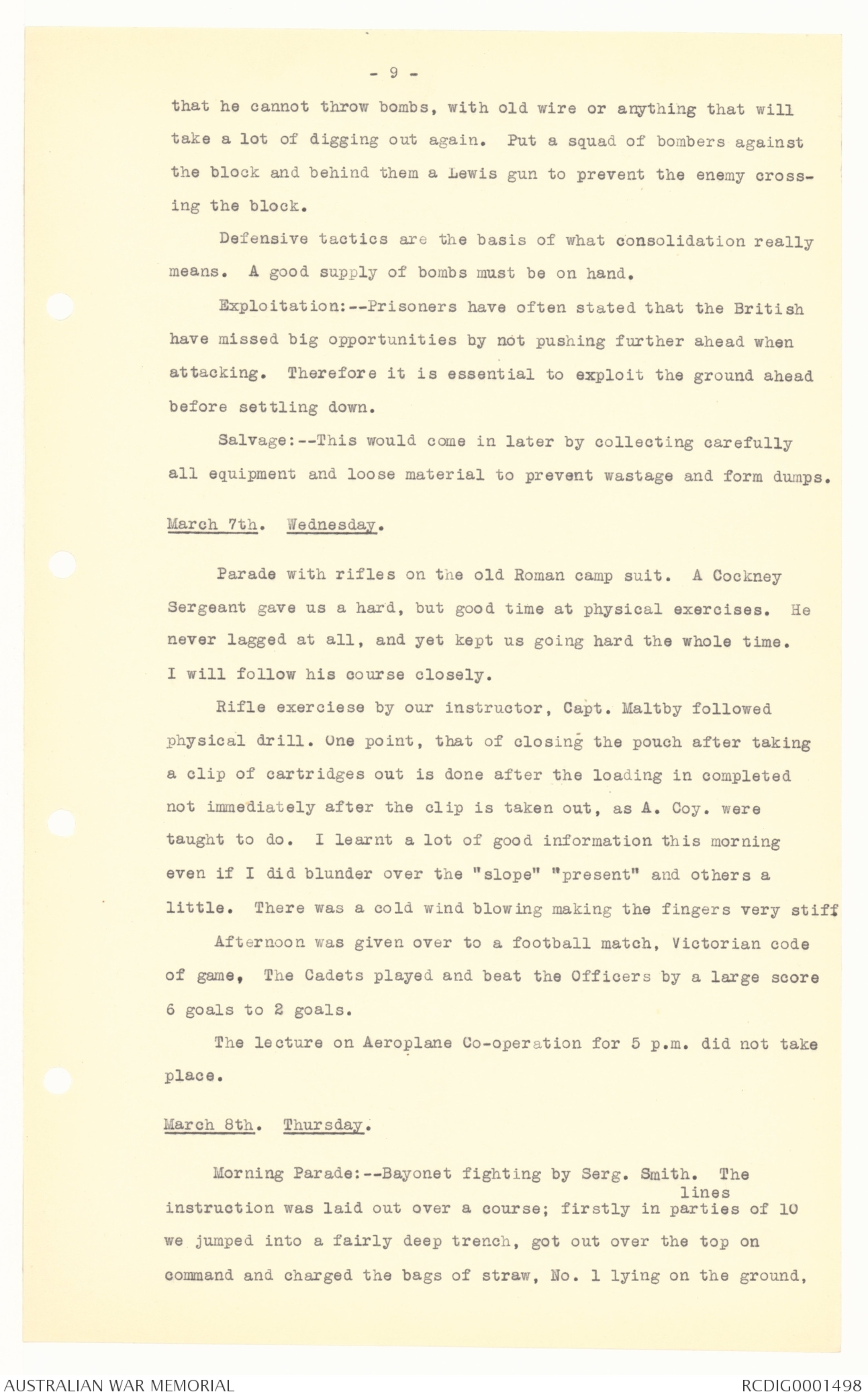


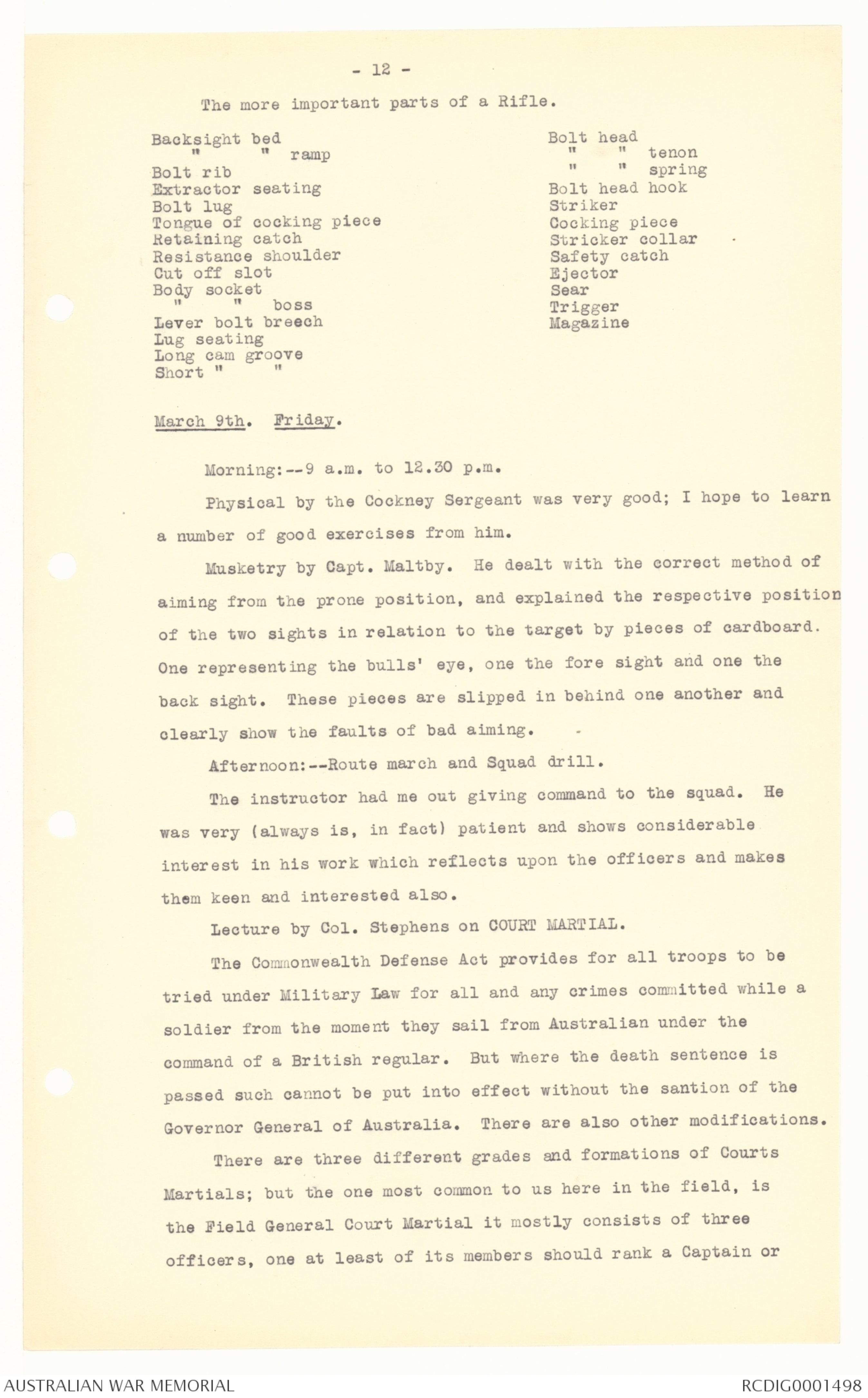
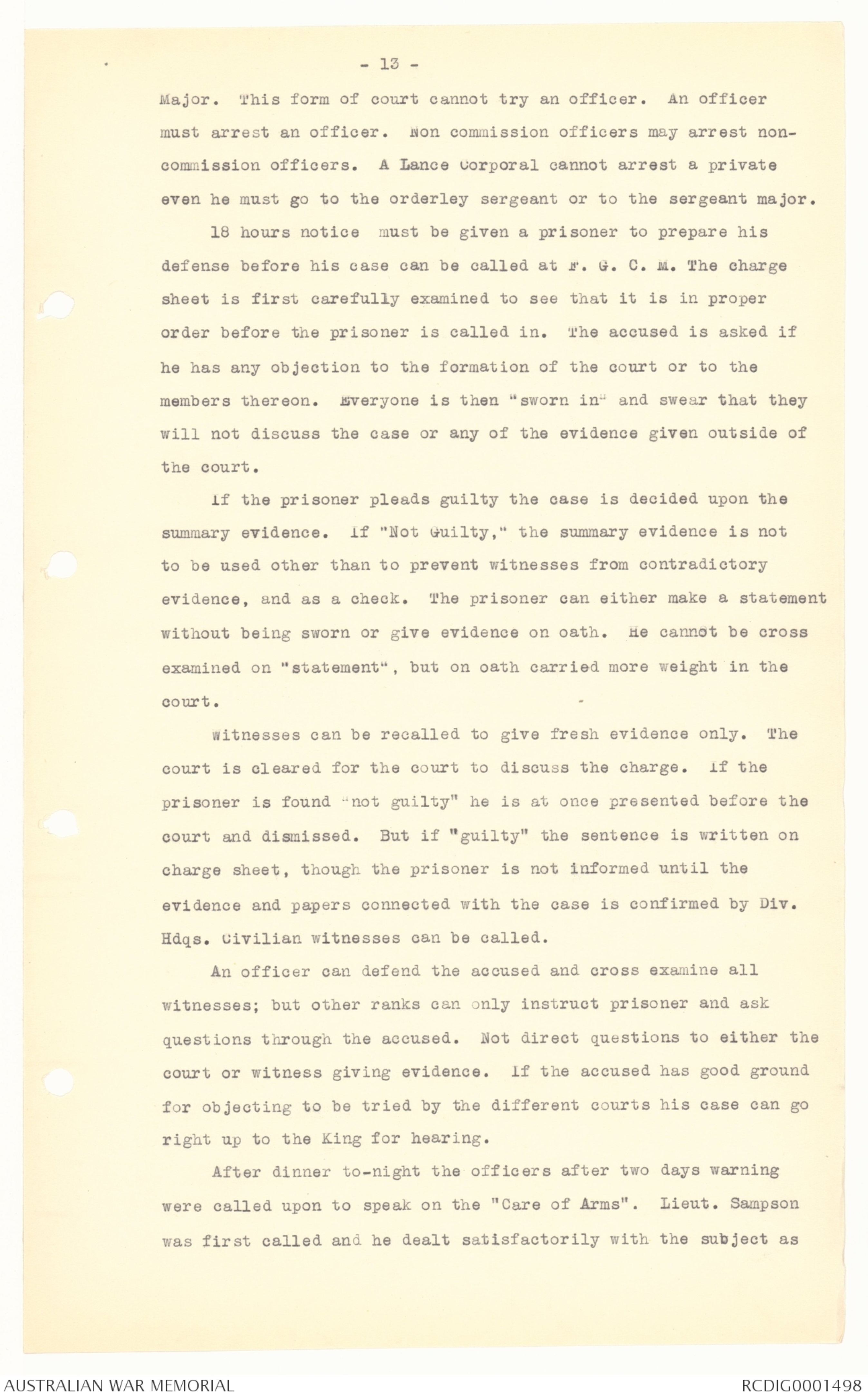
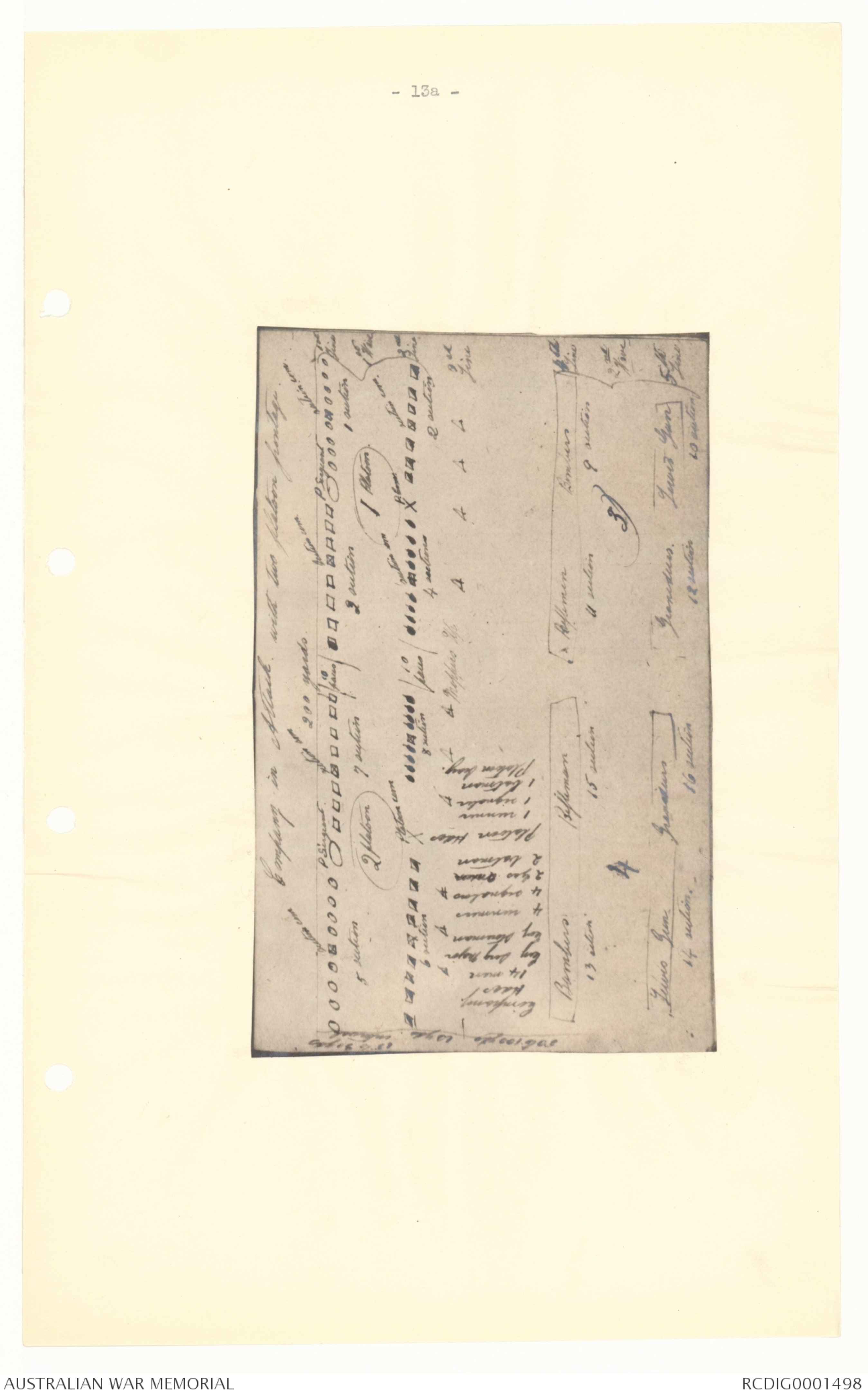
- 5 -
and equip a regular army.
It is said Australian discipline, which we must all agree
with, is anything but good and is much commented upon by all
military authorities in Europe, who have seen them; It should
be a lot better. The personal element will not be injured or
spoilt; by instilling better discipline, the opposite, in fact,
will be the outcome as the personal element so valuable to a
fighting force is always their it is part of your nature and will
not be affected by discipline. Mercantile and commercial businesses,
now seen on so large a scale, are insisting on discipline, in
conjunction with organisation for the success of their affairs.
What mark distinguishes the quality of the different troops?
Behaviour and respect for authority. Too much personal
respect for ability and the man is considered by the men in the
ranks. They must be taught not to respect the individuality of
their officers; but respect the position they hold in the army.
Australians always avoid the necessarty for saluting when possible.
Well discipline and trained troops will always salute properly and
move about with smartness seeing to the cleanlyness of their
uniform and equipment. The Guards for example are proud of their
spick and span appearance, and proud also to belong to a Regiment
in which discipline is strict and a pleasure. Good troops are
good on parade. Australians are unwilling and sluggish on parade.
Reluctant to do their best. It is necessary to check, and tell
regularly, our men about smartness and appearance. Make them
see to their puttees, buttons, hats etc. Take a pride in your
platoon and see that the men do also; Make them feel that their
Company and Battalion should be the smartest and the best of them
all.
Endurance is brought out by discipline and training. During
the American Civil War the young bloods of the North formed themselves
into keen armys but when they set out without training for
the front they soon emptied their water bottles got tired and went
to rags along the road a straggling, useless mob. Men must be
- 6 -
taught to carry and reserve their rations as well as take urgent
care over their water bottles. Australian marching is mostly
ragged and disjointed. Men fall out at will solely from the want
of endurance instilled into them through discipline. With the
possibility of open warfare now being brought in, there is a
greater need than ever for officers to have absolute controle over
their men. Australians will have much difficult is retaining
their fighting name in open war as they as so likely to get out
of hand.
Obedience: - - Instant obedience is essential and shows the power
which the officer has over his men, Men must not hesitate or show
a reluctancy.
Individuality must be strong enough to efficently hold men.
This must be got through firmness in handling the men. The
proper use of authority is a factor in a good platoon. Dont be
sarcastic or nasty it irritates the good men and the bad ones
take no notice of it. Jump right into them and tell them the
correct way to do things and quitely check the faults by details
and patience.
Knowledge an officer or N.C.O. must have he cant possibility
have too much of it and they must know all about their work and
more about it than the men underneath. Book learning is good, but
there must be observation, thought and careful study to complete
one education.
The least thing to rely upon for discipiline is punishment,
such as extra parades and fatigues etc.
Dont have likes and dislikes for particular men treat them
all alike. Officers must hold themselves above other ranks and
have a diginity in keeping with the position they hold. Bad
language to the men only display to them your own ignorance. Be
careful of your own behaviour in your leisure hours especially
when outside or in the presence of lower ranks. Close order drill
is the better for getting good discipline.
The behaviour of your men either on the parade ground or on
the streets is a reflection of your own teaching.
- 7 -
Dinner at 6.30 p.m. and the evening is free.
March 6th, 1916. ^(?) Tuesday.
Morning 9 a.m. to 12.30 p.m.
Squad Drill and Physical Drill:--
A whole lot of time was spent in checking the bumping and
gaps that occurr while on the march or in changing alignment of
almost any kind. While on the march is is often necessary to move
from fours to two and even single file. When getting back into
two or fours always halt or mark time in front so as to allow
the back men to get into their places in comfort and in a good
humour then see that they all move off together at the command
"Quick March". Especial notice must be taken of the blank file
in the forming of fours. I learnt quite a lot of points about
squad drill and also physical drill.
Afternoon. A lecture on Map Reading by Major Harris from
2 p.m. until 3 p.m. Then followed the making of a sketch in one
own fashion only that it must include the features lay down by
our instructor, such as a Road crossing a River, a Railway crossing
the river with a tunnel and cutting, a village with Wells, Church
and Post Office, Trenchs with wire and communication trenches as
well as anything else one wishes to insert.
At 4 p.m. musketry with rifles by our instructor, He went
over the rifle carefully and pleasingly.
5 p.m. a lecture on "Trench Warfare" by Major Harris. Taking
for his main lines the following:--
No. 1 Protection
(a) Advanced posts.
(b) Patroles.
" 2 Reports and Sketches.
" 3 Mopping up.
(a) sentry posted on each dugout and cellars.
(b) clear up dugouts.
(c) Search for Machine Gun positions.
(d) " " " Mines.
" 4 Consolidation
(a) conversion of trench and construction of new
line.
- 8 -
(b) communication trenches.
(c) fortification of forward and strong posts.
(d) bomb blocks.
(e) dumps.
(f) dugouts.
No. 5 Connection.
" 6 Exploitation (fighting patroles
(tactical points
" 7 Information:--documents and prisoners.
" 8 Salvage:--cleaning up etc.
The Major started by explaining that the formation of a
platoon or company in attack is now undergoing alteration and can
not be clearly dealt with just now.
After a trench is captured, however, procetion must at once
be considered and carried out. This will be done chiefly by pushing
advanced posts ahead and in turn protecting them by patroles.
These advanced posts may be required to be be connected to maks
up a new firing line as the enemy will have the artillery range
of same to perfection. Patrols should be accompanyed .by an
officer who will make sketches and take notes to hand into the
Coy. commander, also, he must be clear in his detailing of the
position occupied by his platoon. The Coy. commander in turn will
must report to Br. Hdqs. and if possible submit sketches, in a
rough way. These sketches can be made up before the attack
commences and then be filled up afterwards. Later on a more complete
report will be sent in by Coy. commander.
Moppers up must look carefully about for dugouts post a
sentry and then get busy clearing them out. Another party of
moppers up must look for machine gun positions (hidden probably)
and keep a sharp out look for wires which may be connected with
mines.
Care must be taken in holding an enemys fire trench. Firstly
the artillery will bombard it, and it may not on the other hand
hold a good fire position. So that is most cases it is vantageous
to make a new line altogether in advance. A strong post
is not necessarily forward of the line, it may be behind as long
as to field of fire is good and will enable a counter attack to be
checked.
Block up the enemys communication trench for 40 yards, so
- 9 -
that he cannot throw bombs, with old wire or anything that will
take a lot of digging out again. Put a squad of bombers against
the block and behind them a Lewis gun to prevent the enemy crossing
the block.
Defensive tactics are the basis of what consolidation really
means. A good supply of bombs must be on hand.
Exploitation:--Prisoners have often stated that the British
have missed big opportunities by not pushing further ahead when
attacking. Therefore it is essential to exploit the ground ahead
before settling down.
Salvage:--This would come in later by collecting carefully
all equipment and loose material to prevent wastage and form dumps.
March 7th. Wednesday.
Parade with rifles on the old Roman camp suit. A Cockney
Sergeant gave us a hard, but good time at physical exercises. He
never lagged at all, and yet kept us going hard the whole time.
I will follow his course closely.
Rifle exerciese by our instructor, Capt. Maltby followed
physical drill. One point, that of closing the pouch after taking
a clip of cartridges out is done after the loading in completed
not immediately after the clip is taken out, as A. Coy. were
taught to do. I learnt a lot of good information this morning
even if I did blunder over the "slope" "present" and others a
little. There was a cold wind blowing making the fingers very stiff.
Afternoon was given over to a football match, Victorian code
of game, The Cadets played and beat the Officers by a large score
6 goals to 2 goals.
The lecture on Aeroplane Co-operation for 5 p.m. did not take
place.
March 8th. Thursday.
Morning Parade:--Bayonet fighting by Serg. Smith. The
instruction was laid out over a course; firstly in parties ^lines of 10
we jumped into a fairly deep trench, got out over the top on
command and charged the bags of straw, No. 1 lying on the ground,
- 10 -
withdraw and charge, No. 2, 1½ yds. away suspended, withdraw and
jab the high bag representing the throat, pass on for 20 yds.,
jump into a shallow trench stab a bag on the parapet and race on
5 yards and rest. This was strenuous work but good exercise. I
am very crud at bayonet work; but after having my right shoulder
damaged yesterday I was almost lose to-day.
There followed squad drill with arms and a discourse on
musketry.
Afternoon:--Short lecture on Map Reading by Major Harris:
Followed by each officer enlarging a section of regulation map.
This is rather pleasant and valuable practice. Half an hour on
musketry followed; with "standing load" and target pointing. I
am awfully backward here, but to improve myself I cannot obtain
the book "Musketry No. 1" to help me along.
The evening lecture by a R.F.C. Officer on "AEROPLANE CONTACT."
The only machines doing contact work for the Anzac Corps
are monoplanes. So that when you notice one hovering about
during an attack or shortly afterwards it is looking for information
to take back to Corp Hdqs. It is easily distinguished by
a broard black band on each of the wings and tags flying out behind
from the wi ngs. Its duty at all times is to patrol around the
front lines of both sides and pick up any information to take back
to Hdqs. In an attack it accquaints Hdqs, as to the new position
our troops have taken up and also notes the strength of the German
resistance. During the first two hours of an attack two machines
are on duty. Afterward two hours there is only one.
There are three methods by which the infantry can communicate
with the contact plane.
1st. Flares (Red prefered)
2nd. Ground signaling sheet
3rd. Signaling lamp
The most successful method is the first one. Flares should
be lit in groups of three one yard away from each other and 50
yards between groups.
A succession of A s. from the horn of the contact machine
means that flares are urgently wanted. Should the position arise
in which there are neither flares or ground signaling sheet to be
- 11 -
got it is advisable to make as much movement in the trench as possible.
Such as waving hats and shaking water proof sheets in the
bottom of trench or shell hole.
It is often arranged that attacking troops will light flares
at a certain hour. But should this specificed time arrive and
there is not aeroplane in sight on no account light the flares.
Even if the machine is there dont light up until the machine calls
for them as he may not be in a position to see just then.
Flares are oftimes damp and will not light with the striker;
if this happen just loosen the end a little and use a match to set
it burning.
When using the signaling sheet never attempt more than 6
words per minute making full dots and long dashes. Each letter
will be acknowledged when read by a blast of the horn.
Question asked.
There are no monoplanes in use about the Somme but our contact
aeroplanes. The German do not use monoplanes!! Wireless messages
are sent from the plane but not received!! Photographs are usually
taken at an height of from 7,000 to 12,000 feet. Enough of the
country is then taken in to allow proper identification of the
locality. The best cameras in the service are made with the
lenses taken from German aeroplanes!! Big gun flashes are plainly
seen!! Shells are bursting very close when they can be heard from
the machine!! The Germans dont use shrapnel at planes!! The
clock system of directing gun fire is used and is both clear and
affective. The target is taken as the centre of the clock, whether
visiable or not to the artillery, the 12 hour and 6 hour figure
representing due North and South. for example:--
Diagram- see original document
The centre is the mark each
of the circles represent 10 yards
and are know by the fixed letters.
If a shot land at the cross
(x) the airman wires to the gun
10.A. only and they know just how
to range the next. But should it
land 10 yds. away to the right it
would sent in as "2.Y." This
clock system is also used by Hdqs.
Bn. when calling for a barrage
on a certain place in the line.
- 12 -
The more important parts of a Rifle.
Backsight bed Bolt head
" " ramp " " tenon
Bolt rib " " spring
Extractor seating Bolt head hook
Bolt lug Striker
Tongue of cocking piece Cocking piece
Retaining catch Stricker collar
Resistance shoulder Safety catch
Cut off slot Ejector
Body socket Sear
" " boss Trigger
Lever bolt breech Magazine
Lug seating
Long cam groove
Short " "
March 9th. Friday.
Morning:--9 a.m. to 12.30 p.m.
Physical by the Cockney Sergeant was very good; I hope to learn
a number of good exercises from him.
Musketry by Capt. Maltby. He dealt with the correct method of
aiming from the prone position, and explained the respective position
of the two sights in relation to the target by pieces of cardboard.
One representing the bulls' eye, one the fore sight and one the
back sight. These pieces are slipped in behind one another and
clearly show the faults of bad aiming.
Afternoon:--Route march and Squad drill.
The instructor had me out giving command to the squad. He
was very (always is, in fact) patient and shows considerable
interest in his work which reflects upon the officers and makes
them keen and interested also.
Lecture by Col. Stephens on COURT MARTIAL.
The Commonwealth Defense Act provides for all troops to be
tried under Military Law for all and any crimes committed while a
soldier from the moment they sail from Australian under the
command of a British regular. But where the death sentence is
passed such cannot be put into effect without the santion of the
Governor General of Australia. There are also other modifications.
There are three different grades and formations of Courts
Martials; but the one most common to us here in the field, is
the Field General Court Martial it mostly consists of three
officers, one at least of its members should rank a Captain or
- 13 -
Major. This form of court cannot try an officer. An officer
must arrest an officer. Non commission officers may arrest non-commission
officers. A Lance Corporal cannot arrest a private
even he must go to the orderley sergeant or to the sergeant major.
18 hours notice, must be given a prisoner to prepare his
defense before his case can be called at F. G. C. M. The charge
sheet is first carefully examined to see that it is in proper
order before the prisoner is called in. The accused is asked if
he has any objection to the formation of the court or to the
members thereon. Everyone is then "sworn in" and swear that they
will not discuss the case or any of the evidence given outside of
the court.
If the prisoner pleads guilty the case is decided upon the
summary evidence. If "Not Guilty," the summary evidence is not
to be used other than to prevent witnesses from contradictory
evidence, and as a check. The prisoner can either make a statement
without being sworn or give evidence on oath. He cannot be cross
examined on "statement", but on oath carried more weight in the
court.
Witnesses can be recalled to give fresh evidence only. The
court is cleared for the court to discuss the charge. If the
prisoner is found "not guilty" he is at once presented before the
court and dismissed. But if "guilty" the sentence is written on
charge sheet, though the prisoner is not informed until the
evidence and papers connected with the case is confirmed by Div.
Hdqs. Civilian witnesses can be called.
An officer can defend the accused and cross examine all
witnesses; but other ranks can only instruct prisoner and ask
questions through the accused. Not direct questions to either the
court or witness giving evidence. If the accused has good ground
for objecting to be tried by the different courts his case can go
right up to the King for hearing.
After dinner to-night the officers after two days warning
were called upon to speak on the "Care of Arms". Lieut. Sampson
was first called and he dealt satisfactorily with the subject as
- 13a -
Company in Attack with two platoon frontage
Diagram - see original document
 Marisa Bortolotto
Marisa BortolottoThis transcription item is now locked to you for editing. To release the lock either Save your changes or Cancel.
This lock will be automatically released after 60 minutes of inactivity.